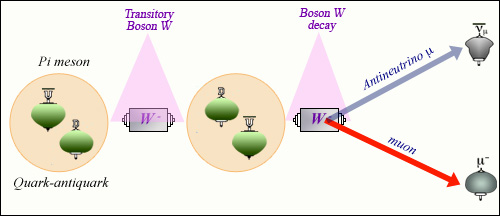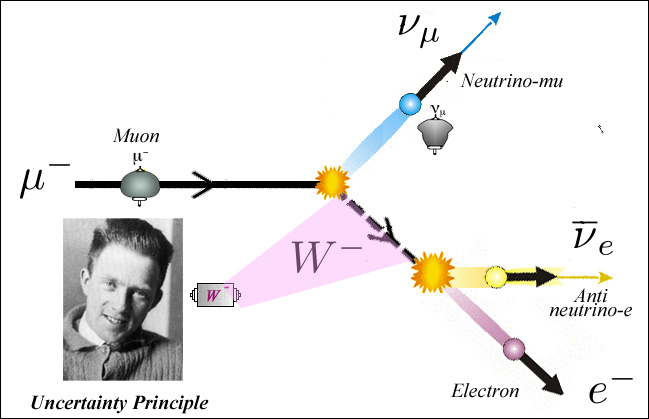An heavy electron abundant in cosmic rays
Muons were first observed in 1936 by the Americans physicists Carl Anderson and Seth Neddermeyer. Carl Anderson discovered also three years before the positive electron
The new particle carried a negative electric charge. Its mass looked intermediate between the masses of an electron and a proton. In order to explain the forces binding protons and neutrons in the nuclei, physicists of the time were looking after the Yukawa meson, a particle having this intermediate mass predicted by the Japanese physicist Hideki Yukawa. Therefore they took the new particle as the Yukawa meson.
The Yukawa meson was not discovered until 1947. it was later on called pion or pi meson. The confusion lasted a decade until 1947. The particle discovered by Anderson and Neddermeyer appeared very different in nature, It did not interact strongly with protons and neutrons. Ii was called the muon.

A source of muons : pi meson decays
The decay of a negative pi meson is the main source of negative muons. The pi meson is made of a quark and an antiquark. Under the effect of weak forces, it can turn during extraordinarily short times into a heavy particle, called W boson. During such transitions, the unstable W boson may decay into a muon and a neutrino mu. The combination of these two transformations causes the death of the pion and gives birth to a muon.
© IN2P3
The muon is considered nowadays a fundamental particle of matter, like the electron, its neutrino and the quarks constituents of the nuclear matter. Like the electron, it is not subject to strong interactions. It has also an alter ego without electric charge, the muonic neutrino or neutrino-mu.
Unlike the electron, the muon is unstable. Its average lifespan is only 2.2 millionths of a second. It has physical properties of electrons but with a mass 207 times greater : its mass energy -mc2 is 105, 66 MeV instead of 0,511 MeV. It can be viewed as a heavy unstable electron. Negative muons are noted μ-. Its antiparticle noted μ +, positively charged, appears as a heavy unstable positron.
The main source of muons is the decay of charged pions, the Yukawa mesons of the 1930’s. The pions or pi mesons themselves are created in the upper atmosphere within cosmic ray showers. Then unstable Muons then decay in turn..
The birth and death of muons are due to two successive decays. The forces behind the birth and death of a muon, which are the same, are called weak interactions or weak forces by nuclear and particle physicists. They are the forces involved also in the beta decay of nuclei.
The weak forces are explained by the role played by a very heavy unstable particle, called the W boson. The existence of the W boson, which was first introduced as an hypothesis, was confirmed by an experiment at CERN in 1983. The role of the W boson in the pi meson and muon decays are allowed by a principle of quantum mechanics at work in the world of the very small, the uncertainty principle enunciated in 1927 by the German physicist Werner Heisenberg.

Muon decay mechanism
Negative muons are unstable and decay within a few microseconds into an electron accompanied by 2 neutrinos. In a first step, the muon turns into a W boson accompanied by a muonic neutrino. This transformation is temporarily authorized by the Heisenberg quantum uncertainty principle. During this very short lived transformation, the W boson can decay into an electron and antineutrino. The combination of these two transformations is energetically permitted. It allows the muon to decay.
© IN2P3
Atmospheric muons
Muons are a component of cosmic rays. When a particle of high energy coming from space collides with a nucleus of the upper atmosphere, it produces a shower of particles that interact and decay in their turn. Among these secondary particles are short lived pi mesons that decay into positive or negative muons which generally live enough long to reach the surface of the earth.
Other articles on the subject « Alpha Beta Gamma rays »
Alpha (α) radioactivity
How heavy nuclei lose weight … by emitting alpha particles Alpha (α) radiation was first ob[...]
Beta (β) radioactivity
How Nature corrects an excess of protons or neutrons Beta (β) radioactivity was first observed in[...]
Beta spectrum
Beta electrons do not have a unique characteristic energy Three particles, the recoil nucleus, th[...]
Electron Capture
A minor mode … competing with positron emission Electron capture is a comparatively minor d[...]
Positron
The positive electron, the first ambassador of antimatter The positron was discovered in 1933 by [...]
The electron-neutrino
An electron that would have lost its electric charge The easiest way to conceive a neutrino is to[...]
Radioactivity Gamma (γ)
How nuclei get rid of excess energy It was in 1900 that the French physicist Paul Villard first f[...]
Nuclear Desexcitations
Gamma are the light emitted by atomic nuclei A french proverb used to say « all roads go to Rome.[...]
Internal Conversion
When a gamma expells an atomic electron and is absorbed Internal conversion is a nucleus desexcit[...]
Nuclear Transmutations
The ancient dream of the alchemists… The alchemists of the Middle Ages and the Renaissance [...]